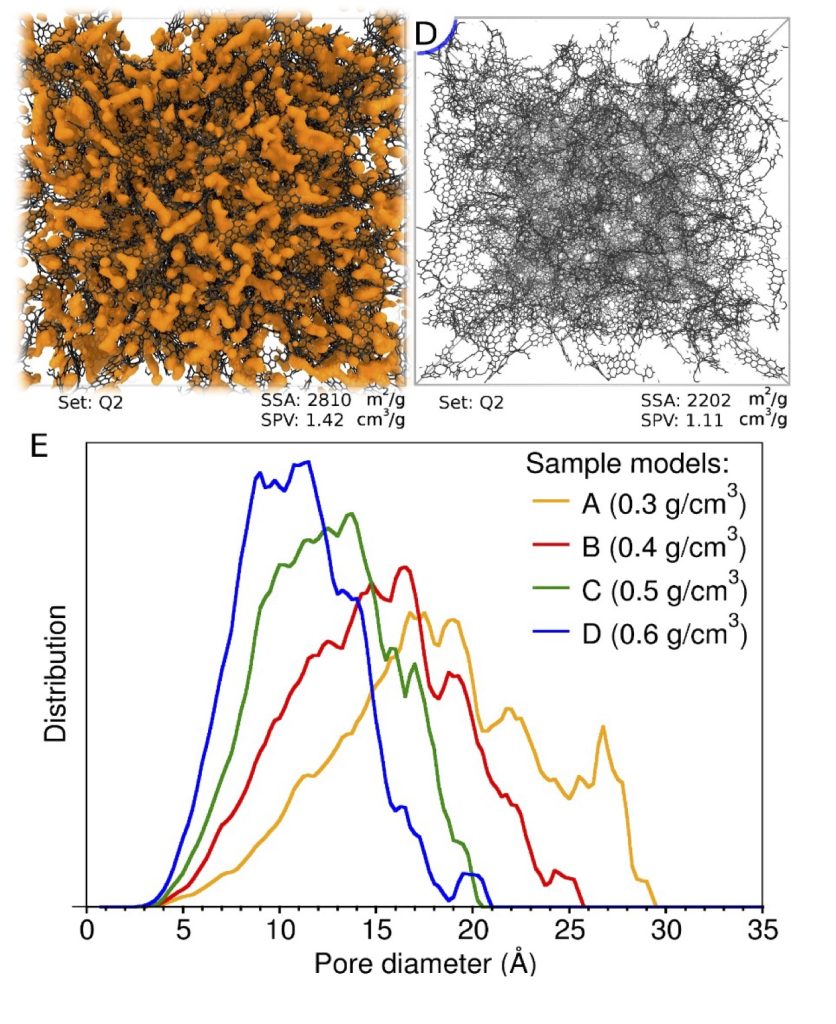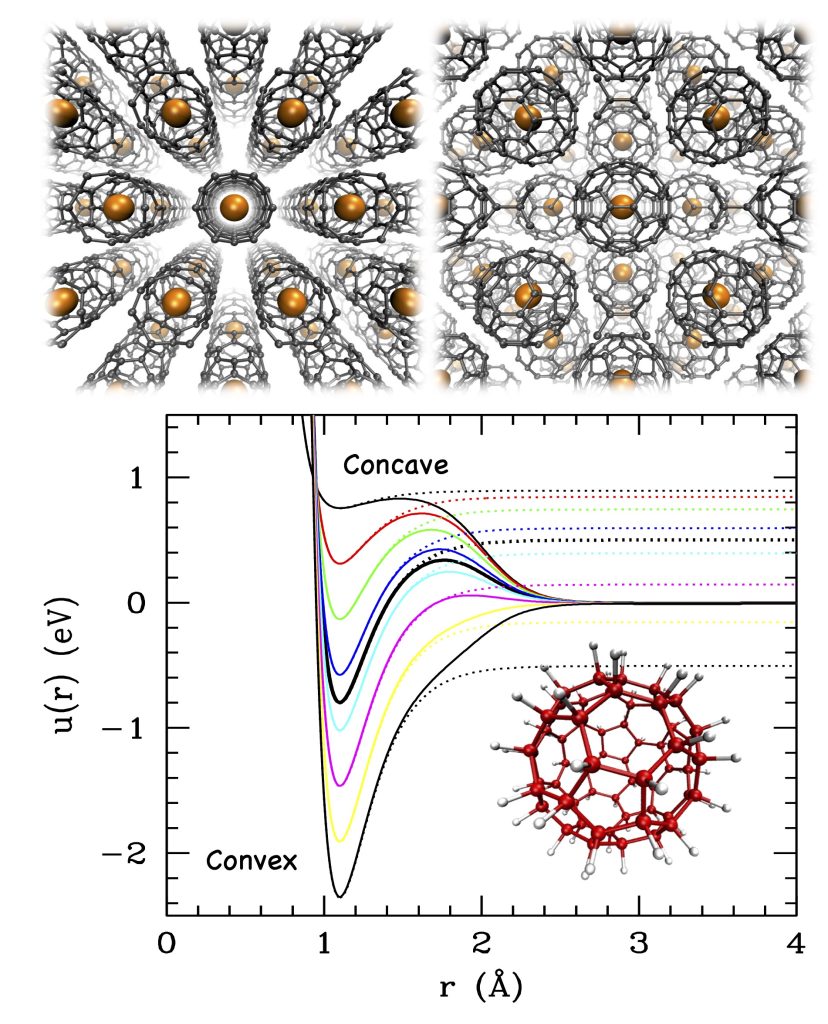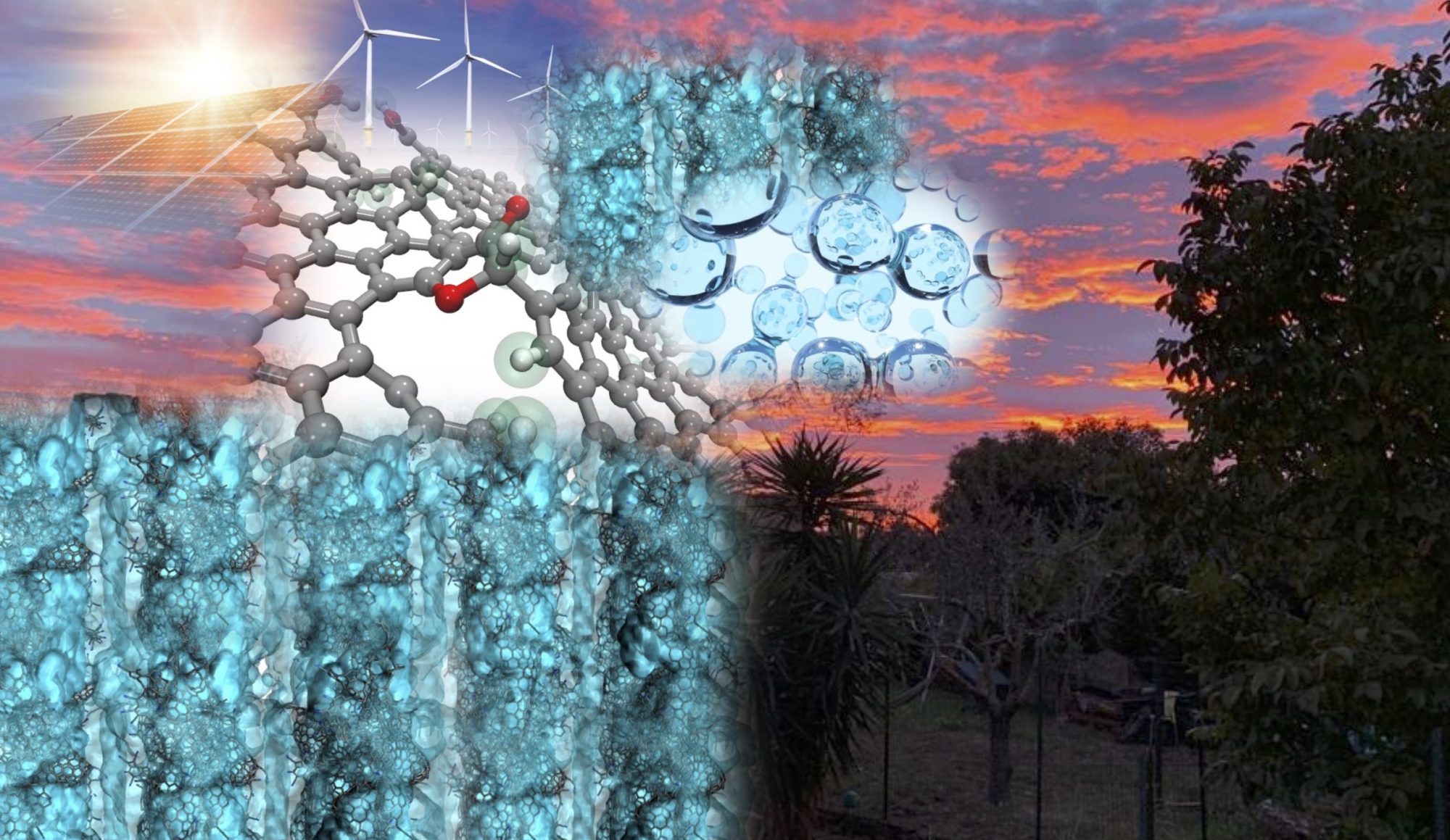The outstanding properties of graphene are well know since its discovery and even earlier. Besides the peculiar band structure leading unique electronic features, equally outstanding are its exceptional resistance to tension, combined with its extreme flexibility, and its 2D nature, resulting in an huge surface-to-mass ratio. The latter, in particular, is exploited in environmental applications, since basically all of them imply the interaction with gases (hydrogen, CO2, methane), or fluids (e.g. water, electrolytes). On the other hand, the same structural characteristics that make it exceptional, can turn into drawbacks: the large exposed surface must be declined in volumetric devices for environmental applications, implying a passage from 2D to 3D; on the other hand, the ideal crystal is rather chemically inert and hydrophobic. The modeling group @NANO has dedicated the last decade to the theoretical analysis and multi-scale simulations of the properties of rippled, strained and defective graphene (stacked or suspended), disordered polycrystalline 2D graphene and nanoporous 3D graphene and aggregates of fullerenes and nanotubes, exploring their interaction with hydrogen for its storage, but also the general capability of trapping other substances, relevant for the production of anti-pollution filters, and other more fundamental properties stemming from imperfection.
Deformed and defective graphene sheets. Epitaxial graphene such as the monolayer obtained evaporating Si from from SiC hexagonal faces, or the quasi free-standing obtained intercalating H or metals, is almost ideal, but still show either regular patterns of corrugation (the former) or almost periodic distributions of localized electronic states (the latter) due to the interaction with the substrate. Our simulations revealed that while physisorption is favored in concanvities, chemisorption is favored onto convexities (video), in agreement with experiments. These properties can be exploited for H-storage devices and for chemical functionalization aimed at building layered 3D structures stabilized by chemical pillars. We are currently also exploring the modulation of reactivity of strained graphene obtained suspending sheets or depositing flakes onto mechanically active substrates.


Disordered 2D and 3D graphenes. 3D nanoporous disordered graphene can be obtained by condensation of inks of graphene flakes esfoliated from graphite. These structures have variable porosity, density and accessible surface. We recently designed and implemented an algorithm to generate model system with given structural properties. We created a large database of these structures with large variability and tested them on their ability to adsorb hydrogen. With the aid of machine learning we extracted quantitative structure-adsorption relationships that can be used to optimize these materials for H-storage. We are also working on polycrystalline 2D graphene, obtained sealing flakes onto a surface. In this case, the hot spots of reactivity interesting for H chemisorption are located on the grain boundaries, rich in topological defects. These, however, generate also other unespected fundamental features, such as pseudo-magnetic fields due to non uniform local strain.
Fullerenes and nanotubes. Graphene sheets can bend to form tubes and closed shells (“fullerenes”) with nano-sized cavities and high curvature. These features are ideal to exploit the enhanced chemical reactivity (on the external surfaces) and enhanced physisorption capability (on the internal cavity). Going beyond the H-storage application, we recently considered these material for an unconventional use related to the detection of the relic post-big bang neutrinos in the cosmic background. Because neutrinos can be detected by their interaction with tritium only if this is kept in atomic form, and at the same time in high volume concentration, we are currently exploring the possibility of encapsulating it into nanotubes or fullerenes, to prevent dimerisation to molecules. These should have the smallest possible diameter, so that the strong concavity prevents the chemisorption, an effect possibly enhanced by external chemical passivation, and subsequently arranged in solid state form, to increase the tritium volumetric density. These studies are performed within the PTOLEMY collaboration on cosmic neutrinos.

| People | Luca Bellucci, Francesco Delfino, Zacharias Fthenakis, ValentinaTozzini* |
| Keywords | Deformation and defects in graphene, polycrystalline graphene, nanotubes, fullerenes, nanoporous graphene, physisorption vs chemisorption of hydrogen, reactivity of graphene |
| Methods, techniques | Density Functional Theory – Based calculations, Molecular Dynamics with atomistic reactive force fields |
| Granted projects | PRIN 2018 MONSTRE2D 2020-2023 MONolithic STRain Engineering platform for TWODimensional materials. PI Alessandro Tredicucci, UniPi, CNR-unit coordinator, Valentina Tozzini |
| HPC grants | |
| 2023 ISCRA-B: Structural, Electronic and magnetic properties of Tritium Encapsulated fullerite for high energy and quantum computing applications (SETE), 240KCoreh on Tier0 Leonardo@CINECA PI: Valentina Tozzini | |
| 2019 ISCRA-B: Diffusion within Nano-porous Graphene (DiNaGra), 750Kh on Tier0 Marconi@CINECA PI: Valentina Tozzini | |
| 2016-2017 PRACE: Simulation driven Morphing of supported Graphene (SMoG) 15Mh on Tier0 Marconi@CINECA PI: Valentina Tozzini | |
| 2016-2017 ISCRA-C: Quasi Free Standing Graphene Monolayer on SiC with H coverage vacancies: A Density Functional Theory study (QFSGvac) 200Kh on Tier0 Marconi@CINECA PI: Valentina Tozzini | |
| 2015-2016 ISCRA-C: Electro-mechanical manipulation of graphene reactivity (ElMaGRe) 1Mh on Tier0 Fermi@CINECA PI: Valentina Tozzini | |
| 2015 ISCRA-B: Flexoelectricity in naturally corrugated graphene: a DFT study (FlexoGra) 7Mh on Tier0 Fermi@CINECA PI: Valentina Tozzini | |
| 2013-2014 PRACE: Controlling Hydrogen Binding to Corrugated Graphene 38Mh on Tier0 Fermi@CINECA PI: Valentina Tozzini | |
| 2013 ISCRA-C: Hydrogen on buckled graphene (HBG) 5Mh on Tier0 Fermi@CINECA PI: Valentina Tozzini | |
| Collaborations | Guido Menichetti, IIT and Dept Physics, University of Pisa; PTOLEMY, a world-wide collaboration on the detection and study of cosmic neutrino background |
| Publications | |
| F Delfino, C Ros, SM Palardonio, NM Carretero, S Murcia-López, J R Morante, J Martorell, Z G Fthenakis, M F Sgroi, V Tozzini, L Bellucci Multi-methodological analysis of hydrogen desorption from graphene Carbon | |
| MG Betti, […] V tozzini et al .Cosmic Neutrino Background detection with PTOLEMY Pos Proc Sci 2024 | |
| ZG Fthenakis, ID Petsalakis, V Tozzini, NN Lathiotakis Evaluating the performance of ReaxFF potentials for sp2 carbon systems (graphene, carbon nanotubes, fullerenes) and a new ReaxFF potential Front Chem 2022 | |
| A Apponi, […] V Tozzini et al, PTOLEMY collaboration Heisenberg’s uncertainty principle in the PTOLEMY project: A theory update Phys Rev D 2022 | |
| L Bellucci, F Delfino, V Tozzini In Silico design, building and gas adsorption of nano-porous graphene scaffolds Nanotechnology 2021 | |
| L Bellucci, V Tozzini Engineering 3d graphene-based materials: State of the art and perspectives Molecules 2020 | |
| L Bellucci, T Cavallucci, V Tozzini From the buffer layer to graphene on silicon carbide: exploring morphologies by computer modeling Front Mater 2019 | |
| T Cavallucci, V Tozzini Intrinsic structural and electronic properties of the Buffer Layer on Silicon Carbide unraveled by Density Functional Theory Sci Rep 2018 | |
| T Cavallucci, Y Murata, M Takamura, H Hibino, S Heun, V Tozzini Unraveling localized states in quasi free standing monolayer graphene by means of Density Functional Theory Carbon 2018 | |
| VD Camiola, V Tozzini Collective Mode Mining from Molecular Dynamics Simulations: A Comparative Approach Int J Comput Methods 2018 | |
| Y. Murata, T. Cavallucci, V. Tozzini, N. Pavlicek, L. Gross, G. Meyer, M. Takamura, H. Hibino, F. Beltram, and S. Heun: Atomic and electronic structure of Si dangling bonds in quasi-free standing monolayer graphene, Nano Research 2018 | |
| T Cavallucci, V Tozzini Multistable Rippling of Graphene on SiC: A Density Functional Theory Study J Phys Chem C 2016 | |
| A Rossi, S Piccinin, V Pellegrini, S de Gironcoli, V Tozzini Nano-Scale Corrugations in Graphene: a Density Functional Theory Study of Structure, Electronic Properties and Hydrogenation J Phys Chem C 2015 | |
| VD Camiola, R Farchioni, T Cavallucci, A Rossi, V Pellegrini, V Tozzini Hydrogen storage in rippled graphene: perspectives from multi-scale simulations Front Mater 2015 | |
| F Bonaccorso, L Colombo, G Yu, M Stoller, V Tozzini, AC Ferrari, RS Ruof, V Pellegrini Graphene, related two-dimensional crystals, and hybrid systems for energy conversion and storage Science 2015 | |
| VD Camiola, R Farchioni, V Pellegrini, V Tozzini Hydrogen transport within graphene multilayers by means of flexural phonons 2D Mater 2015 | |
| T. Mashoff, D. Convertino, V. Miseikis, C. Coletti, V. Piazza, V. Tozzini, F. Beltram, and S. Heun Increasing the active surface of titanium islands on graphene by nitrogen sputtering, Appl. Phys. Lett. 2015 | |
| S Goler, C Coletti, V Tozzini, V Piazza, T Mashoff, F Beltram, V Pellegrini, S Heun The Influence of Graphene Curvature on Hydrogen Adsorption: Towards Hydrogen Storage Devices J Phys chem C 2013 | |
| V Tozzini, V Pellegrini Prospects for hydrogen storage in graphene Phys Chem Chem Phys 2013 |
* Contact person: valentina.tozzini@nano.cnr.it

